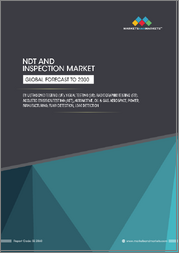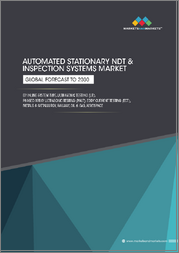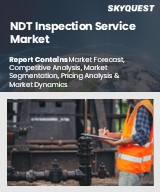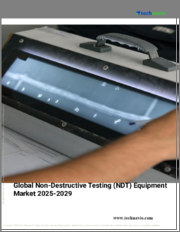
|
시장보고서
상품코드
1734834
세계의 비파괴 검사(NDT) 시장 예측(-2032년) : 방법, 기기, 기술, 용도, 최종 사용자, 지역별 분석Non-Destructive Testing (NDT) Market Forecasts to 2032 - Global Analysis By Method (Visual Inspection, Surface Inspection, Volumetric Inspection, and Other Methods), Equipment, Technology, Application, End User and By Geography |
||||||
Stratistics MRC에 따르면 세계의 비파괴 검사(NDT) 시장은 2025년에 248억 달러, 2032년에는 463억 달러에 이를것으로 예측되며, 예측 기간 동안 CAGR은 9.3%를 나타낼 전망입니다.
비파괴 검사(NDT)는 손상을 일으키지 않고 재료의 무결성을 평가하는 데 사용되는 일련의 검사 기법입니다. 초음파 검사, 방사선 촬영, 자성 입자 검사 등의 방법이 있으며 항공우주, 건설, 제조 분야에 적용됩니다. NDT는 구조적 안전을 보장하고 결함을 감지하며 산업 표준 준수 여부를 확인합니다. 치명적인 고장을 예방함으로써 제품의 신뢰성과 수명을 향상시켜 중요 인프라 및 산업 구성 요소의 유지보수 비용과 가동 중단 시간을 줄입니다.
석유 및 가스 및 전력 부문의 성장
석유 및 가스 및 전력 부문의 확대로 장비 무결성을 보장하기 위한 비파괴 검사에 대한 수요가 증가하고 있습니다. 엄격한 안전 규정으로 인해 정기적인 검사가 필요해지면서 시장 성장이 촉진되고 있습니다. 노후화된 인프라가 증가함에 따라 첨단 검사 방법이 필요합니다. 비파괴 검사 기술의 혁신은 정확성과 효율성을 향상시킵니다. 신흥 시장의 에너지 수요 증가는 시장 확대를 뒷받침합니다. 비용이 많이 드는 고장을 예방하는 데 초점을 맞추면 채택률이 높아집니다. NDT는 운영 안전을 보장하여 시장 성장을 촉진합니다.
높은 장비 비용
초음파 및 방사선 촬영 시스템과 같은 고급 NDT 장비에는 상당한 자본 투자가 필요합니다. 높은 비용은 중소기업의 도입을 저해합니다. 숙련된 작업자가 필요하기 때문에 교육 비용도 증가합니다. 빠른 기술 발전은 잦은 장비 업등급를 필요로 합니다. 개발도상국에서는 자금 조달에 대한 접근성이 제한되어 시장 침투를 방해합니다. 정교한 시스템에 대한 높은 유지보수 비용은 재정적 부담을 가중시킵니다. 이러한 비용 장벽은 비파괴 검사 시장의 확장성을 제한합니다.
비파괴 검사 분야에 AI 및 머신러닝 도입
비파괴 검사에 AI와 머신러닝을 통합하면 결함 검출과 데이터 분석 정확도가 향상됩니다. 자동화된 검사 시스템은 인적 오류를 줄이고 효율성을 개선합니다. 인더스트리 4.0의 성장 추세는 AI 기반 NDT 도입을 뒷받침합니다. 기술 기업과 NDT 제공업체 간의 파트너십은 혁신을 촉진합니다. 첨단 검사 기술에 대한 규제 지원은 투자를 장려합니다. 중요 산업에서 실시간 모니터링에 대한 필요성이 높아지면서 기회가 증가하고 있습니다.
대체 검사 방법과의 경쟁
파괴 검사 및 육안 모니터링과 같은 대체 검사 방법은 비용에 민감한 용도에서 NDT와 경쟁하고 있습니다. 이러한 방법은 더 간단하고 전문 장비가 덜 필요합니다. NDT의 장기적인 이점에 대한 인식 부족은 도입을 제한합니다. 드론 기반 검사와 같은 경쟁 기술의 발전은 시장 점유율에 도전하고 있습니다. NDT의 높은 초기 비용은 소규모 사용자의 도입을 저해합니다. 하이브리드 검사 솔루션으로의 전환은 NDT에 대한 의존도를 낮춥니다. 이러한 경쟁은 NDT 시장의 성장을 위협하고 있습니다.
COVID-19의 영향 :
COVID-19 팬데믹은 석유 및 가스, 제조 부문의 활동 감소로 인해 NDT 운영에 차질을 빚었습니다. 봉쇄 조치로 인프라 프로젝트가 지연되면서 검사 서비스 수요에 영향을 미쳤습니다. 하지만 드론 기반 검사와 같은 원격 NDT 솔루션이 주목을 받았습니다. 공급망 중단은 장비 생산과 배송에 영향을 미쳤습니다. 팬데믹은 신뢰할 수 있는 자산 모니터링의 필요성을 강조하며 위기 이후 수요를 견인했습니다. 노동력 부족과 여행 제한은 현장 검사를 방해했습니다. 에너지와 제조업의 회복은 시장 성장을 촉진할 것으로 예상됩니다.
육안 검사 부문은 예측 기간 동안 가장 큰 규모가 될 전망
육안 검사 부문은 비용 효율성과 산업 전반에 걸친 광범위한 사용으로 인해 예측 기간 동안 가장 큰 시장 점유율을 차지할 것으로 예상됩니다. 육안 검사는 장비의 표면 결함을 식별하는 중요한 첫 단계입니다. 드론 및 카메라와 같은 이미징 기술의 발전은 이 부문의 성장을 촉진합니다. 일상적인 검사에 대한 규제 요건이 도입을 촉진합니다. 석유 및 가스 및 전력 부문에서 육안 검사의 다목적성이 시장 점유율을 강화합니다. 신뢰할 수 있는 검사 방법에 대한 소비자의 신뢰와 예방적 유지보수에 대한 관심이 이 부문을 강화합니다.
초음파 검사 부문은 예측 기간 동안 가장 높은 CAGR을 가질 전망
예측 기간 동안 초음파 검사 부문은 중요 인프라의 내부 결함을 감지하는 높은 정확도로 인해 가장 높은 성장률을 보일 것으로 예상됩니다. 초음파 장비의 혁신은 검사 효율성과 신뢰성을 향상시킵니다. 전력 및 석유 및 가스 부문의 노후화된 인프라가 증가하면서 수요가 증가하고 있습니다. 엄격한 안전 점검에 대한 규제 의무는 세그먼트 확장을 지원합니다. 기술 기업과의 파트너십은 초음파 검사에 AI 통합을 촉진합니다. 비침습적 검사 방법에 대한 필요성은 채택을 촉진합니다.
최대 점유율을 차지하는 지역 :
예측 기간 동안 아시아태평양 지역은 중국과 인도와 같은 국가의 탄탄한 석유 및 가스 및 제조 산업으로 인해 가장 큰 시장 점유율을 차지할 것으로 예상됩니다. 급속한 산업화와 인프라 개발로 인해 NDT에 대한 수요가 증가하고 있습니다. 에너지 및 안전 규제에 대한 정부의 투자가 시장 성장을 뒷받침하고 있습니다. 주요 NDT 장비 제조업체의 존재는 지역 지배력을 강화합니다. 에너지 수요 증가는 검사 수요를 촉진합니다. 인프라 현대화에 대한 관심이 채택률을 높입니다.
CAGR이 가장 높은 지역 :
예측 기간 동안 북미 지역은 석유 및 가스 및 전력 부문의 첨단 기술 채택에 힘입어 가장 높은 CAGR을 기록할 것으로 예상됩니다. 이 지역의 엄격한 안전 규정으로 인해 고정밀 NDT에 대한 수요가 증가하고 있습니다. 테스트를 위한 AI 및 머신러닝에 대한 투자가 시장 성장을 촉진하고 있습니다. 선도적인 NDT 서비스 제공업체의 존재는 혁신을 촉진합니다. 자산 유지보수에 대한 인식이 높아지면서 도입이 증가하고 있습니다.
무료 맞춤화 서비스 :
이 보고서를 구독하는 고객은 다음 무로 맞춤화 옵션 중 하나를 사용할 수 있습니다.
- 기업 프로파일
- 추가 시장 기업의 종합적 프로파일링(최대 3개사)
- 주요 기업의 SWOT 분석(최대 3개사)
- 지역 세분화
- 고객의 관심에 응한 주요국 시장 추계, 예측 및 CAGR(참고 : 타당성 확인에 따라 다름)
- 경쟁 벤치마킹
- 제품 포트폴리오, 지리적 존재, 전략적 제휴에 기반한 주요 기업 벤치마킹
목차
제1장 주요 요약
제2장 서문
- 개요
- 이해관계자
- 조사 범위
- 조사 방법
- 데이터 마이닝
- 데이터 분석
- 데이터 검증
- 조사 접근
- 조사 자료
- 1차 조사 자료
- 2차 조사 자료
- 전제조건
제3장 시장 동향 분석
- 성장 촉진요인
- 억제요인
- 기회
- 위협
- 기술 분석
- 용도 분석
- 최종 사용자 분석
- 신흥 시장
- COVID-19의 영향
제4장 Porter's Five Forces 분석
- 공급기업의 협상력
- 구매자의 협상력
- 대체품의 위협
- 신규 참가업체의 위협
- 경쟁 기업간 경쟁 관계
제5장 세계의 비파괴 검사(NDT) 시장 : 방법별
- 육안 검사
- 표면 검사
- 용적 검사
- 기타 방법
제6장 세계의 비파괴 검사(NDT) 시장 : 기기별
- 기기 렌탈
- NDT 제품
제7장 세계의 비파괴 검사(NDT) 시장 : 기술별
- 초음파 검사
- 육안 검사
- 자성 입자 검사
- 액체 침투 시험
- 와전류 검사
- 방사선 검사
- 음향 방출 시험
- 기타 기술
제8장 세계의 비파괴 검사(NDT) 시장 : 용도별
- 검사 서비스
- 교육 및 인증
- 교정 서비스
- 데이터 분석 및 보고서
- 자산 관리
- 기타 용도
제9장 세계의 비파괴 검사(NDT) 시장 : 최종 사용자별
- 제조
- 석유 및 가스
- 항공우주
- 공공 인프라
- 자동차
- 발전
- 기타 최종 사용자
제10장 세계의 비파괴 검사(NDT) 시장 : 지역별
- 북미
- 미국
- 캐나다
- 멕시코
- 유럽
- 독일
- 영국
- 이탈리아
- 프랑스
- 스페인
- 기타 유럽
- 아시아태평양
- 일본
- 중국
- 인도
- 호주
- 뉴질랜드
- 한국
- 기타 아시아태평양
- 남미
- 아르헨티나
- 브라질
- 칠레
- 기타 남미
- 중동 및 아프리카
- 사우디아라비아
- 아랍에미리트(UAE)
- 카타르
- 남아프리카
- 기타 중동 및 아프리카
제11장 주요 발전
- 계약, 파트너십, 협업, 합작투자
- 인수와 합병
- 신제품 발매
- 사업 확대
- 기타 주요 전략
제12장 기업 프로파일링
- Previan Technologies, Inc.
- Bureau Veritas
- Fischer Technology Inc.(Helmut Fischer)
- MISTRAS Group
- Comet Group(YXLON International)
- MME Group
- TWI Ltd.
- Nikon Corporation
- Olympus Corporation
- Sonatest
- Acuren
- Intertek Group plc
- CREAFORM
- SGS SA
- General Electric
According to Stratistics MRC, the Global Non-Destructive Testing (NDT) Market is accounted for $24.8 billion in 2025 and is expected to reach $46.3 billion by 2032 growing at a CAGR of 9.3% during the forecast period. Non-Destructive Testing (NDT) is a suite of inspection techniques used to evaluate material integrity without causing damage. Methods include ultrasonic testing, radiography, and magnetic particle inspection, applied in aerospace, construction, and manufacturing. NDT ensures structural safety, detects flaws, and verifies compliance with industry standards. By preventing catastrophic failures, it enhances product reliability and lifespan, reducing maintenance costs and downtime in critical infrastructure and industrial components.
Market Dynamics:
Driver:
Growth in oil & gas and power sectors
The expansion of the oil & gas and power sectors is driving demand for non-destructive testing to ensure equipment integrity. Stringent safety regulations require regular inspections, boosting market growth. The rise in aging infrastructure necessitates advanced testing methods. Innovations in NDT technologies improve accuracy and efficiency. Growing energy demand in emerging markets supports market expansion. The focus on preventing costly failures enhances adoption. NDT ensures operational safety, propelling market growth.
Restraint:
High equipment costs
Advanced NDT equipment, such as ultrasonic and radiographic systems, involves significant capital investment. High costs deter small and medium-sized enterprises from adoption. The need for skilled operators increases training expenses. Rapid technological advancements require frequent equipment upgrades. Limited access to financing in developing regions hinders market penetration. High maintenance costs for sophisticated systems add financial strain. This cost barrier restricts the scalability of the NDT market.
Opportunity:
Adoption of AI and machine learning in NDT
The integration of AI and machine learning in NDT enhances defect detection and data analysis accuracy. Automated inspection systems reduce human error and improve efficiency. The growing trend of Industry 4.0 supports AI-driven NDT adoption. Partnerships between tech firms and NDT providers foster innovation. Regulatory support for advanced inspection technologies encourages investment. The need for real-time monitoring in critical industries boosts opportunities.
Threat:
Competition from alternative inspection methods
Alternative inspection methods, such as destructive testing and visual monitoring, compete with NDT in cost-sensitive applications. These methods are simpler and require less specialized equipment. Lack of awareness about NDT's long-term benefits limits adoption. Advances in competing technologies, like drone-based inspections, challenge market share. High initial costs of NDT deter small-scale users. The shift toward hybrid inspection solutions reduces reliance on NDT. This competition threatens the growth of the NDT market.
Covid-19 Impact:
The COVID-19 pandemic disrupted NDT operations due to reduced activity in oil & gas and manufacturing sectors. Lockdowns delayed infrastructure projects, impacting demand for testing services. However, the rise in remote NDT solutions, such as drone-based inspections, gained traction. Supply chain disruptions affected equipment production and delivery. The pandemic highlighted the need for reliable asset monitoring, driving post-crisis demand. Labor shortages and travel restrictions hindered on-site testing. Recovery in energy and manufacturing is expected to boost market growth.
The visual inspection segment is expected to be the largest during the forecast period
The visual inspection segment is expected to account for the largest market share during the forecast period propelled by its cost-effectiveness and widespread use across industries. Visual inspection is a critical first step in identifying surface defects in equipment. Advances in imaging technologies, like drones and cameras, enhance segment growth. Regulatory requirements for routine inspections drive adoption. The versatility of visual inspection in oil & gas and power sectors strengthens market share. Consumer trust in reliable inspection methods and the focus on preventive maintenance bolsters this segment.
The ultrasonic testing segment is expected to have the highest CAGR during the forecast period
Over the forecast period, the ultrasonic testing segment is predicted to witness the highest growth rate driven by its high accuracy in detecting internal defects in critical infrastructure. Innovations in ultrasonic equipment improve testing efficiency and reliability. The rise in aging infrastructure in power and oil & gas sectors fuels demand. Regulatory mandates for stringent safety checks support segment expansion. Partnerships with tech firms drive AI integration in ultrasonic testing. The need for non-invasive inspection methods boosts adoption.
Region with largest share:
During the forecast period, the Asia Pacific region is expected to hold the largest market share owing to its robust oil & gas and manufacturing industries in countries like China and India. Rapid industrialization and infrastructure development drive demand for NDT. Government investments in energy and safety regulations support market growth. The presence of key NDT equipment manufacturers strengthens regional dominance. Rising energy demand fuels inspection needs. The focus on modernizing infrastructure enhances adoption.
Region with highest CAGR:
Over the forecast period, the North America region is anticipated to exhibit the highest CAGR fueled by advanced technological adoption in oil & gas and power sectors. The region's stringent safety regulations drive demand for high-precision NDT. Investments in AI and machine learning for testing enhance market growth. The presence of leading NDT service providers fosters innovation. Growing awareness of asset maintenance boosts adoption.
Key players in the market
Some of the key players in Non-Destructive Testing (NDT) Market include Previan Technologies, Inc., Bureau Veritas, Fischer Technology Inc. (Helmut Fischer), MISTRAS Group, Comet Group (YXLON International), MME Group, TWI Ltd., Nikon Corporation, Olympus Corporation, Sonatest, Acuren, Intertek Group plc, CREAFORM, SGS S.A., and General Electric.
Key Developments:
In April 2025, Olympus Corporation launched its next-generation AI-powered ultrasonic testing system, featuring automated flaw detection with 99.5% accuracy, reducing inspection time by 40% for aerospace and energy applications.
In March 2025, MISTRAS Group introduced a portable digital radiography solution for field inspections, enabling real-time defect visualization and cloud-based reporting for oil & gas pipeline maintenance teams.
In February 2025, Nikon Corporation unveiled a high-resolution X-ray CT system, enhancing battery inspection precision by 25% for electric vehicle manufacturing.
Methods Covered:
- Visual Inspection
- Surface Inspection
- Volumetric Inspection
- Other Methods
Equipments Covered:
- Equipment Rental
- NDT Product
Technologies Covered:
- Ultrasonic Testing
- Visual Inspection Testing
- Magnetic Particle Testing
- Liquid Penetrant Testing
- Eddy-Current Testing
- Radiographic Testing
- Acoustic Emission Testing
- Other Technologies
Applications Covered:
- Inspection Service
- Training And Certification
- Calibration Service
- Data Analysis And Reporting
- Asset Management
- Other Applications
End Users Covered:
- Manufacturing
- Oil & Gas
- Aerospace
- Public Infrastructure
- Automotive
- Power Generation
- Other End Users
Regions Covered:
- North America
- US
- Canada
- Mexico
- Europe
- Germany
- UK
- Italy
- France
- Spain
- Rest of Europe
- Asia Pacific
- Japan
- China
- India
- Australia
- New Zealand
- South Korea
- Rest of Asia Pacific
- South America
- Argentina
- Brazil
- Chile
- Rest of South America
- Middle East & Africa
- Saudi Arabia
- UAE
- Qatar
- South Africa
- Rest of Middle East & Africa
What our report offers:
- Market share assessments for the regional and country-level segments
- Strategic recommendations for the new entrants
- Covers Market data for the years 2024, 2025, 2026, 2028, and 2032
- Market Trends (Drivers, Constraints, Opportunities, Threats, Challenges, Investment Opportunities, and recommendations)
- Strategic recommendations in key business segments based on the market estimations
- Competitive landscaping mapping the key common trends
- Company profiling with detailed strategies, financials, and recent developments
- Supply chain trends mapping the latest technological advancements
Free Customization Offerings:
All the customers of this report will be entitled to receive one of the following free customization options:
- Company Profiling
- Comprehensive profiling of additional market players (up to 3)
- SWOT Analysis of key players (up to 3)
- Regional Segmentation
- Market estimations, Forecasts and CAGR of any prominent country as per the client's interest (Note: Depends on feasibility check)
- Competitive Benchmarking
- Benchmarking of key players based on product portfolio, geographical presence, and strategic alliances
Table of Contents
1 Executive Summary
2 Preface
- 2.1 Abstract
- 2.2 Stake Holders
- 2.3 Research Scope
- 2.4 Research Methodology
- 2.4.1 Data Mining
- 2.4.2 Data Analysis
- 2.4.3 Data Validation
- 2.4.4 Research Approach
- 2.5 Research Sources
- 2.5.1 Primary Research Sources
- 2.5.2 Secondary Research Sources
- 2.5.3 Assumptions
3 Market Trend Analysis
- 3.1 Introduction
- 3.2 Drivers
- 3.3 Restraints
- 3.4 Opportunities
- 3.5 Threats
- 3.6 Technology Analysis
- 3.7 Application Analysis
- 3.8 End User Analysis
- 3.9 Emerging Markets
- 3.10 Impact of Covid-19
4 Porters Five Force Analysis
- 4.1 Bargaining power of suppliers
- 4.2 Bargaining power of buyers
- 4.3 Threat of substitutes
- 4.4 Threat of new entrants
- 4.5 Competitive rivalry
5 Global Non-Destructive Testing (NDT) Market, By Method
- 5.1 Introduction
- 5.2 Visual Inspection
- 5.3 Surface Inspection
- 5.4 Volumetric Inspection
- 5.5 Other Methods
6 Global Non-Destructive Testing (NDT) Market, By Equipment
- 6.1 Introduction
- 6.2 Equipment Rental
- 6.3 NDT Product
7 Global Non-Destructive Testing (NDT) Market, By Technology
- 7.1 Introduction
- 7.2 Ultrasonic Testing
- 7.3 Visual Inspection Testing
- 7.4 Magnetic Particle Testing
- 7.5 Liquid Penetrant Testing
- 7.6 Eddy-Current Testing
- 7.7 Radiographic Testing
- 7.8 Acoustic Emission Testing
- 7.9 Other Technologies
8 Global Non-Destructive Testing (NDT) Market, By Application
- 8.1 Introduction
- 8.2 Inspection Service
- 8.3 Training And Certification
- 8.4 Calibration Service
- 8.5 Data Analysis And Reporting
- 8.6 Asset Management
- 8.7 Other Applications
9 Global Non-Destructive Testing (NDT) Market, By End User
- 9.1 Introduction
- 9.2 Manufacturing
- 9.3 Oil & Gas
- 9.4 Aerospace
- 9.5 Public Infrastructure
- 9.9 Automotive
- 9.7 Power Generation
- 9.8 Other End Users
10 Global Non-Destructive Testing (NDT) Market, By Geography
- 10.1 Introduction
- 10.2 North America
- 10.2.1 US
- 10.2.2 Canada
- 10.2.3 Mexico
- 10.3 Europe
- 10.3.1 Germany
- 10.3.2 UK
- 10.3.3 Italy
- 10.3.4 France
- 10.3.5 Spain
- 10.3.6 Rest of Europe
- 10.4 Asia Pacific
- 10.4.1 Japan
- 10.4.2 China
- 10.4.3 India
- 10.4.4 Australia
- 10.4.5 New Zealand
- 10.4.6 South Korea
- 10.4.7 Rest of Asia Pacific
- 10.5 South America
- 10.5.1 Argentina
- 10.5.2 Brazil
- 10.5.3 Chile
- 10.5.4 Rest of South America
- 10.6 Middle East & Africa
- 10.6.1 Saudi Arabia
- 10.6.2 UAE
- 10.6.3 Qatar
- 10.6.4 South Africa
- 10.6.5 Rest of Middle East & Africa
11 Key Developments
- 11.1 Agreements, Partnerships, Collaborations and Joint Ventures
- 11.2 Acquisitions & Mergers
- 11.3 New Product Launch
- 11.4 Expansions
- 11.5 Other Key Strategies
12 Company Profiling
- 12.1 Previan Technologies, Inc.
- 12.2 Bureau Veritas
- 12.3 Fischer Technology Inc. (Helmut Fischer)
- 12.4 MISTRAS Group
- 12.5 Comet Group (YXLON International)
- 12.6 MME Group
- 12.7 TWI Ltd.
- 12.8 Nikon Corporation
- 12.9 Olympus Corporation
- 12.10 Sonatest
- 12.11 Acuren
- 12.12 Intertek Group plc
- 12.13 CREAFORM
- 12.14 SGS S.A.
- 12.15 General Electric



















